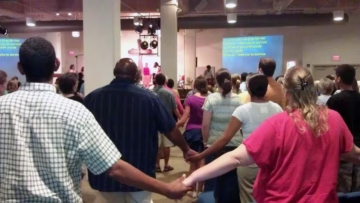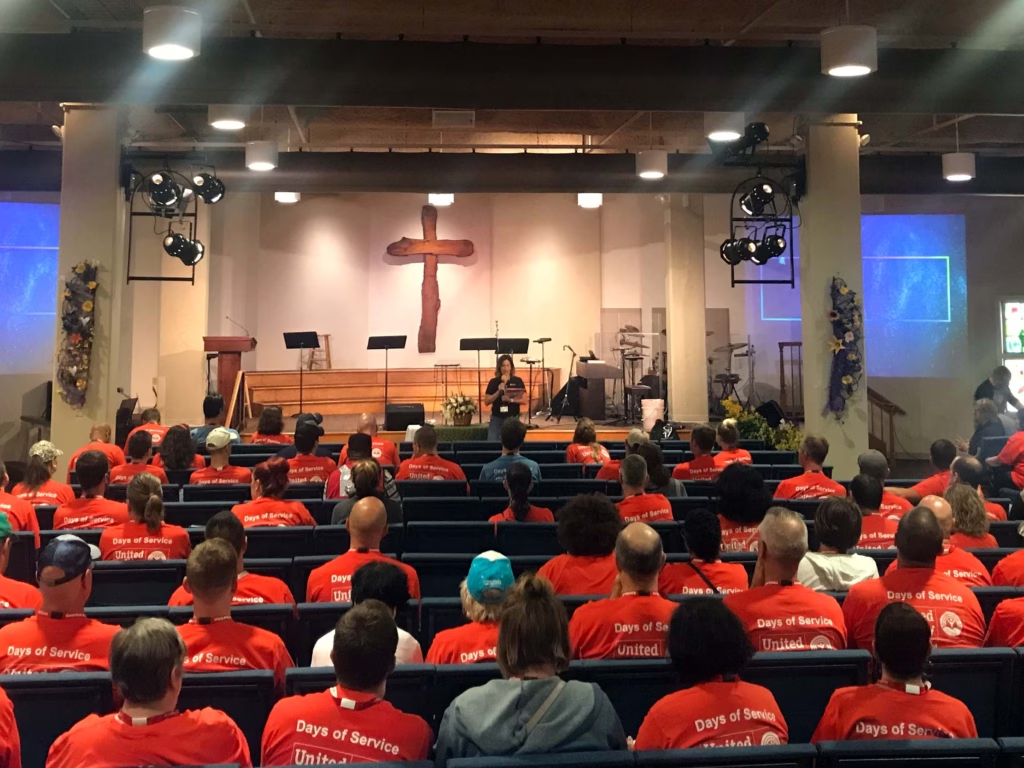
This article’s crux, like the rest of Scripture, hangs on the Great Commandment (Matt. 22:37-40) to love the Lord with all our heart, soul, and mind, and to love our neighbors as we love ourselves. In other words, loving the Lord and loving our neighbors isn’t up for a debate among followers of Jesus. Yet it isn’t always clear who our neighbor is, or what is required of us when we encounter them. For instance, on one hand the Great Commandment seems to push us far beyond loving only the neighbors who are physically near us. But on the other hand, if everyone is our neighbor, then no one really seems to be.
Since 2004, I have had the privilege to be a member of Harrisburg Brethren in Christ (HBIC) church. Our congregation consistently asks questions about how to faithfully love God and neighbor in a diverse urban context. On any given Sunday, you can find us worshipping in an old car dealership off Derry Street in Allison Hill, a diverse urban neighborhood just a few miles from Pennsylvania’s State Capitol Complex. While our church building is in the city, many in our congregation come from rural and suburban as well as urban contexts.

Considering the diverse array of people represented in our community, and the wide range of places where God has put them, it is necessary to nuance the ways we talk about following the Great Commandment and how we put this into context. Where we all live and work profoundly shapes how HBIC aspires to share Christ’s love and serve the needs of our local and global communities. Suffice it to say, this zesty mix of people and places makes for many catalytic conversations about how to faithfully love our neighbors.
What follows are five snippets from what we are learning at HBIC as we sketch out “neighboring” as a particular practice of how we can love people and our local neighborhoods:
1. Start where you are
Regardless of whether you find yourself living on a farm, cul-de-sac, or in a row home, neighboring begins by being intentional about knowing and interacting with those around you. When it is informed and animated by the Spirit, neighboring can turn strangers into friends who can be united across great differences by the grace of God. It can engender the fruits of the Spirit in our lives, our homes, and at our work. In short, neighboring has the powerful potential to engage us in the work of God to make the earth a little more like it is in heaven.
2. Love people for who they are
How we go about neighboring reveals to us (and others) not only how we think about the Great Commandment but also how we understand the Great Commission (Matt. 28:18-20). Neighboring is not a church growth tactic that turns people into targets to hit for conversion quotas, nor is it an assimilation scheme to get those around us to become more like us, thinking, believing, and doing the same things we do. Rather, neighboring helps us love people because they are made in the image of God. We practice neighboring because God’s grace is seen not only in our personal salvation but also in the renewal of our neighborhoods.
3. Take the Great Commandment literally
Metaphorical love for metaphorical neighbors leads us to very abstract conversations that aren’t helpful. To get “unstuck,” we launched a six-week book study on The Art of Neighboring with about twenty-five people who are trying to take the Great Commandment literally and then discuss what it means to love our neighbors where God has placed us. As you can imagine, this can be awkward and messy work, but it has helped some of us develop more skills for ambiguity when we encounter difference and diversity around us. It has also reminded us that we don’t have the corner market on the Kingdom of God as our eyes are opened through neighboring to see how God is at work in unsuspected places.
4. Work for justice in changing neighborhoods
Neighboring must be practiced at more than just an interpersonal level where it can too narrowly focus on building warm relationships with individuals who live next door. For neighboring to be truly transformative, we must take seriously that not only might our neighbors also be our enemies, but that there are powerful systems and structures that have created and continue to sustain, and perpetuate injustice, violence, and poverty. Toward that end, we are beginning to merge the demographic data coming out of our denomination’s Project 250 initiative with other research projects to investigate where HBIC’s local neighborhood has come from, what is affecting it now, and where it is headed in the future. The data has been a welcomed tool to help us increase our understanding of our local neighborhood and how it is changing so we can better love, care, and serve our neighbors where they are.
5. Keep a prophetic imagination
Keeping our neighboring practices focused on how we can be more responsive to the changing environments that our neighbors are experiencing has helped us prophetically imagine what the Kingdom of God might look like, as opposed to centering how HBIC could more closely mirror the trends around us. We must never use demographic realities to justify being monocultural. Simply saying that our congregations reflect the community around us doesn’t take seriously how our neighborhoods have been engineered to produce the resulting demographic realities resulting from systems and structures at work in our place. (For instance, one only needs to consider how federal redlining practices carved out areas in Harrisburg for funneling resources for economic development into some neighborhoods and not others based on race and ethnicity.)
These are just some of the neighboring lessons we are learning along the way as we engage the changing realities of the communities around us. We have much more to learn, and we don’t have all the answers, but it isn’t about that anyway. As a prospective member at HBIC recently shared with our congregation when they were inducted into membership one Sunday morning, “I’m here because you tell your story [of Christ at work] and love your neighbor.”
This was originally published in the Fall 2022 issue of SHALOM! A Journal for the Practice of Reconciliation, under the title “Engaging with Changing Community Realities.”



